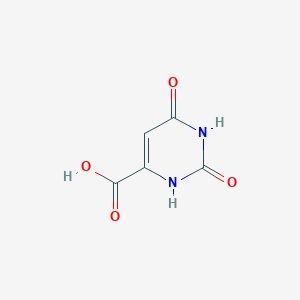Details of Metabolite
| Full List of Protein(s) Regulating This Metabolite | ||||||
|---|---|---|---|---|---|---|
| GPCR secretin (GPCR-2) | ||||||
| Glucagon receptor (GCGR) | Click to Show/Hide the Full List of Regulating Pair(s): 1 Pair(s) | |||||
| Detailed Information |
Protein Info
 click to show the details of this protein click to show the details of this protein
|
|||||
| Regulating Pair |
Experim Info
 click to show the details of experiment for validating this pair click to show the details of experiment for validating this pair
|
[1] | ||||
| Introduced Variation | Knockout of Gcgr | |||||
| Induced Change | Orotic acid concentration: increase (FC = 1.6) | |||||
| Summary | Introduced Variation
|
|||||
| Disease Status | Type 2 diabetes mellitus [ICD-11: 5A11] | |||||
| Details | It is reported that knockout of GCGR leads to the increase of orotic acid levels compared with control group. | |||||
| Hydrolases (EC 3) | ||||||
| Leukotriene-C4 hydrolase (GGT1) | Click to Show/Hide the Full List of Regulating Pair(s): 1 Pair(s) | |||||
| Detailed Information |
Protein Info
 click to show the details of this protein click to show the details of this protein
|
|||||
| Regulating Pair |
Experim Info
 click to show the details of experiment for validating this pair click to show the details of experiment for validating this pair
|
[2] | ||||
| Introduced Variation | Knockdown (siRNA) of GGT1 | |||||
| Induced Change | Orotic acid concentration: increase | |||||
| Summary | Introduced Variation
|
|||||
| Disease Status | Renal cell carcinoma [ICD-11: 2C90] | |||||
| Details | It is reported that knockdown of GGT1 leads to the increase of orotic acid levels compared with control group. | |||||
| Transferases (EC 2) | ||||||
| Arylamine N-acetyltransferase 1 (NAT1) | Click to Show/Hide the Full List of Regulating Pair(s): 1 Pair(s) | |||||
| Detailed Information |
Protein Info
 click to show the details of this protein click to show the details of this protein
|
|||||
| Regulating Pair |
Experim Info
 click to show the details of experiment for validating this pair click to show the details of experiment for validating this pair
|
[3] | ||||
| Introduced Variation | Knockout of NAT1 | |||||
| Induced Change | Orotic acid concentration: decrease (FC = 0.1) | |||||
| Summary | Introduced Variation
|
|||||
| Disease Status | Breast cancer [ICD-11: 2C60] | |||||
| Details | It is reported that knockout of NAT1 leads to the decrease of orotic acid levels compared with control group. | |||||
| Citrate synthase (CS) | Click to Show/Hide the Full List of Regulating Pair(s): 1 Pair(s) | |||||
| Detailed Information |
Protein Info
 click to show the details of this protein click to show the details of this protein
|
|||||
| Regulating Pair |
Experim Info
 click to show the details of experiment for validating this pair click to show the details of experiment for validating this pair
|
[4] | ||||
| Introduced Variation | Knockdown (shRNA) of CS | |||||
| Induced Change | Orotic acid concentration: increase | |||||
| Summary | Introduced Variation
|
|||||
| Disease Status | Lung cancer [ICD-11: 2C25] | |||||
| Details | It is reported that knockdown of CS leads to the increase of orotic acid levels compared with control group. | |||||
| Pyridoxal kinase (PDXK) | Click to Show/Hide the Full List of Regulating Pair(s): 1 Pair(s) | |||||
| Detailed Information |
Protein Info
 click to show the details of this protein click to show the details of this protein
|
|||||
| Regulating Pair |
Experim Info
 click to show the details of experiment for validating this pair click to show the details of experiment for validating this pair
|
[5] | ||||
| Introduced Variation | Knockout (CRISPR/Cas9 sgRNA) of Pdxk | |||||
| Induced Change | Orotic acid concentration: decrease | |||||
| Summary | Introduced Variation
|
|||||
| Disease Status | Acute myeloid leukaemia [ICD-11: 2A60] | |||||
| Details | It is reported that knockout of Pdxk leads to the decrease of orotic acid levels compared with control group. | |||||
If you find any error in data or bug in web service, please kindly report it to Dr. Zhang and Dr. Mou.

